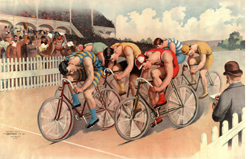By Sue Giles
Bristol Museums, Galleries & Archives
Whatever one’s view of religion or relics, the exhibition Treasures of Heaven: saints, relics and devotion in medieval Europe at the British Museum was a feast of extraordinary art and craft from the middle ages, from Rome via 10th century Byzantium to 15th century France. It included stunning Limoges enamel reliquary boxes and gold and silver reliquary statues. Looking at the objects was one thing, watching the visitors another.
A man I thought was cleaning sticky marks off the glass of one case was, I realised, making the sign of the cross repeatedly – possibly with his mobile ‘phone in his hand - was he filming his actions? A woman came up to the same case and held her hand flat on the glass, channelling the relic. Near another case, I was aware that standing behind me were a man saying his rosary and a woman whispering prayers.
Alas, no one else can go and watch the visitors – I visited on the last afternoon of the exhibition and the relics have been returned to their respective museums and churches. For me, the exhibition raised questions of belief – why do people believe that someone thought to save the Virgin Mary’s breast milk all those centuries ago? If all the pieces of the true cross were put together, how big would the cross be? Was it faith that created relics, or economic and political need?
 |
The Kandy Temple elephant carrying the Tooth relic,
full moon, August 2007 |
That said, the exhibition also made me think about why and how different religions come up with similar practices and ideas. Several of the reliquaries contained the toothes of saints. These relic would have been wrapped and placed in a reliquary casket, to be carried in procession under a panoply.
During the Kandy perahera in Sri Lanka, the Temple of the Tooth is represented in the parade of the four Kandy temples, processing around the town every night for a month. On a few nights, the Tooth relic actually carried on the back of an elephant, wrapped in a reliquary box, and paraded under a panoply held up on poles by six men. Other nights the elephant parades with an empty palanquin.
On most nights people just watch the elephant pass by. When he carries the Tooth relic, they stand and bow....
Religion must be the new black – as
Treasures of Heaven closed,
Infinitas Gracias: Mexican miracle paintings opened at the Wellcome Collection. This is another fascinating exhibition about religious belief, showing over 100 examples of Mexican votive paintings – created to record of an event where the dedicatee believed that only the intervention of Jesus, Mary or a saint had saved them or their family from death by cancer, amputation, bandits, drowning, electrocution, car crashes, heart attacks....
The small paintings on tinplate are in a naive style. In some, the space is full with the scene of the accident, the saint and the dedication, in others the rectangular ‘canvas’ is very empty – perhaps a huge room with a chequered floor, a small bed in one corner and the saint hovering in another.
The paintings are arranged as art works in a single line around the walls of the gallery – but at the entrance a display of reproductions shows how they would be seen by the faithful, with hundreds nailed up cheek by jowl to cover the walls of the church.
One wall in the exhibition holds a collection of contemporary
ex-votos from the church of Real de Catorce, an old silver mining community. People rarely commission a painting now, but anyone can pin up a prayer or a photograph, a child’s baby-grow or a wedding dress, all dedicated to St Anthony as thanks for anything from getting a job to falling pregnant or recovering from illness.
 |
A Sacred Heart milagro or ex-voto offering,
purchased Mexico City, 1991 |
Anyone can present a
milagro or little silver or brass pendant of what they need help with, be it their eyesight, their dog or their car, and at the church of Real de Catorce these are used to create decorate the walls.
Visitors to these exhibitions fall into different camps: those who believe in the power of the things on display, those with faith but not in Catholicism, and those who see the objects as art, and wonder why people believe a saint would hear their prayer and help them.
Alongside
Infinatas Gracias at the Wellcome is another exhibition,
Charmed Life: the solace of objects, an artist’s interpretation of a collection of amulets made by the Edwardian folklorist Edward Lovett. The juxtaposition of votive offerings from Mexico with fabric-covered horseshoes to protect against nightmares and coral hands to ward off the evil eye is an interesting one – in both cases the objects seem to be created by belief.
Treasures of Heaven has closed, but Infinitas Gracias and Charmed Life at the Wellcome Collection are open until 26 February
 The 2012 conference of the Museums and Galleries History Group, to be held at the University of Lincoln 12-13 July 2012
The 2012 conference of the Museums and Galleries History Group, to be held at the University of Lincoln 12-13 July 2012 




































